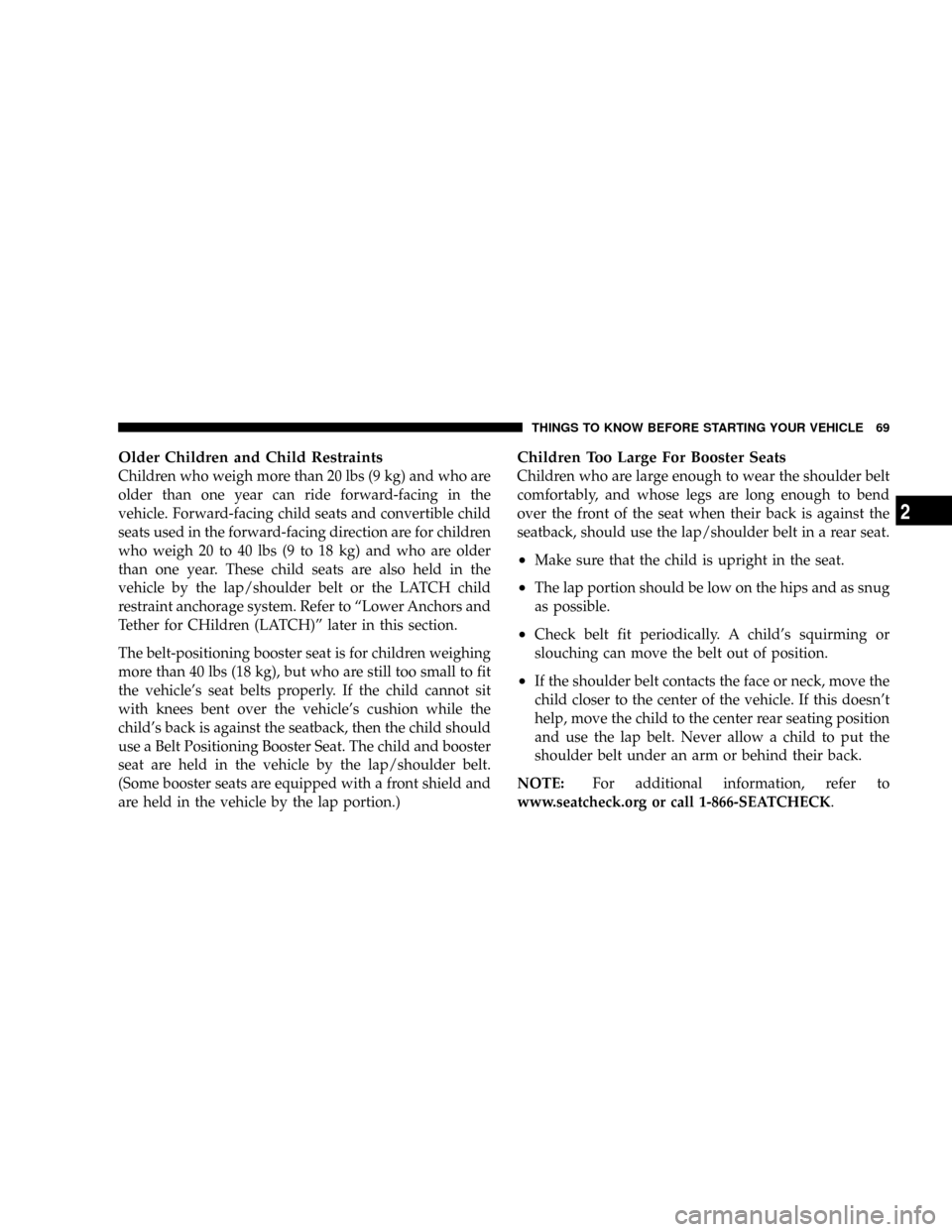Page 69 of 457

Older Children and Child Restraints
Children who weigh more than 20 lbs (9 kg) and who are
older than one year can ride forward-facing in the
vehicle. Forward-facing child seats and convertible child
seats used in the forward-facing direction are for children
who weigh 20 to 40 lbs (9 to 18 kg) and who are older
than one year. These child seats are also held in the
vehicle by the lap/shoulder belt or the LATCH child
restraint anchorage system. Refer to ªLower Anchors and
Tether for CHildren (LATCH)º later in this section.
The belt-positioning booster seat is for children weighing
more than 40 lbs (18 kg), but who are still too small to fit
the vehicle's seat belts properly. If the child cannot sit
with knees bent over the vehicle's cushion while the
child's back is against the seatback, then the child should
use a Belt Positioning Booster Seat. The child and booster
seat are held in the vehicle by the lap/shoulder belt.
(Some booster seats are equipped with a front shield and
are held in the vehicle by the lap portion.)
Children Too Large For Booster Seats
Children who are large enough to wear the shoulder belt
comfortably, and whose legs are long enough to bend
over the front of the seat when their back is against the
seatback, should use the lap/shoulder belt in a rear seat.
²Make sure that the child is upright in the seat.
²The lap portion should be low on the hips and as snug
as possible.
²Check belt fit periodically. A child's squirming or
slouching can move the belt out of position.
²If the shoulder belt contacts the face or neck, move the
child closer to the center of the vehicle. If this doesn't
help, move the child to the center rear seating position
and use the lap belt. Never allow a child to put the
shoulder belt under an arm or behind their back.
NOTE:For additional information, refer to
www.seatcheck.org or call 1-866-SEATCHECK.
THINGS TO KNOW BEFORE STARTING YOUR VEHICLE 69
2
Page 70 of 457

WARNING!
²Improper installation can lead to failure of an
infant or child restraint. It could come loose in a
collision. The child could be badly injured or
killed. Follow the manufacturer's directions ex-
actly when installing an infant or child restraint.
²A rearward facing child restraint should only be
used in a rear seat. A rearward facing child re-
straint in the front seat may be struck by a deploy-
ing passenger airbag which may cause severe or
fatal injury to the infant.
Here are some tips on getting the most out of your child
restraint:
²Before buying any restraint system, make sure that it
has a label certifying that it meets all applicable Safety
Standards. We also recommend that you make surethat you can install the child restraint in the vehicle
where you will use it, before you buy it.
²The restraint must be appropriate for your child's
weight and height. Check the label on the restraint for
weight and height limits.
²Carefully follow the instructions that come with the
restraint. If you install the restraint improperly, it may
not work when you need it.
The passenger seat belts are equipped with cinching
latch plates, which are designed to keep the lap
portion tight around the child restraint so that it is not
necessary to use a locking clip. Pulling up on the
shoulder portion of the lap/shoulder belt will tighten
the belt. The cinching latch plate will keep the belt
tight, however, any seat belt system will loosen with
time, so check the belt occasionally and pull it tight if
necessary.
70 THINGS TO KNOW BEFORE STARTING YOUR VEHICLE
Page 71 of 457

²In the rear seat, you may have trouble tightening the
lap/shoulder belt on the child restraint because the
buckle or latch plate is too close to the belt path
opening on the restraint. Disconnect the latch plate
from the buckle and twist the short buckle end of the
belt several times to shorten it. Insert the latch plate
into the buckle with the release button facing out.
²If the belt still can't be tightened, or if pulling and
pushing on the restraint loosens the belt, disconnect
the latch plate from the buckle, turn the buckle
around, and insert the latch plate into the buckle
again. If you still can't make the child restraint secure,
try a different seating position.
²Buckle the child into the seat according to the child
restraint manufacturer's directions.
²When your child restraint is not in use, secure it in the
vehicle with the seat belt or remove it from the vehicle.
Don't leave it loose in the vehicle. In a sudden stop or
collision, it could strike the occupants or seatbacks and
cause serious personal injury.
Lower Anchors and Tether for CHildren (LATCH)
Each vehicle is equipped with two child restraint anchor-
age systems called LATCH, which stands for Lower
Anchors and Tether for CHildren. The LATCH child
restraint anchorage systems are installed on second-row
seats only. LATCH child restraint anchorage systems are
not provided on the six passenger third row seats.
THINGS TO KNOW BEFORE STARTING YOUR VEHICLE 71
2
Page 72 of 457
Six passenger vehicles are equipped with second row
fold & tumble seats with lower anchorages that can
accommodate rigid mount or flexible webbing-mounted
LATCH-compatible child seats. The third row seating
positions are not equipped with lower anchorages. How-
ever, the third row driver side seating position is
equipped with a tether anchor. If you are installing
LATCH-compatible child restraints in any third row
seating position, you must use the vehicle's seat belt.
Five passenger vehicles are equipped with a second row
bench seat only. The two outboard seating positions have
lower anchorages that can accommodate rigid mount or
flexible webbing-mounted LATCH-compatible child
seats. The center seating position of the bench seat can
LATCH ANCHORS
72 THINGS TO KNOW BEFORE STARTING YOUR VEHICLE
Page 73 of 457

also accommodate a flexible webbing-mounted LATCH-
compatible child seat by using the inboard lower anchors
of the two outboard seating positions. A rigid mount seat
can only be installed at this seating location by using the
vehicle's seat belt. Regardless of the specific type of lower
attachment, NEVER install LATCH-compatible child
seats such that two child seats share a common lower
anchorage. If you are installing LATCH-compatible child
restraints in adjacent rear seating positions, you can use
the LATCH anchors or the vehicle's seat belt for the
outboard position, but you must use the vehicle's seat
belt at the center position.
The lower anchor bars of the LATCH System are located
where the seat back meets the seat cushion. The tether
anchors are located on the rear surface of the seat. Child
restraint systems designed to be compatible with the
vehicles LATCH System are now available. LATCH child
restraints make installation into the vehicle simple and
Bench Seat LATCH Anchors
THINGS TO KNOW BEFORE STARTING YOUR VEHICLE 73
2
Page 74 of 457

convenient. When using the LATCH System, always
follow the child restraint manufacturer's installation in-
structions.
NOTE:If your child restraint seat is not LATCH com-
patible, install the restraint using the vehicle seat belts.
Tether Anchors
There are tether strap anchorages behind all second row
seating positions and for six passenger vehicles on the
driver's side third row seating position. The tether an-
chors are located in the rear surface of the seat. When
using the tether anchorages in the second row fold &
tumble seating positions and in the outboard second row
bench seating positions, ensure that the strap is routed
over the top of the seatback and under the head restraint
between the head restraint posts.When the tether anchorage is used in the center second
row bench seating position or on the third row seating
position, where equipped, the strap should be positioned
straight over the top of the seatback.
2ND ROW TETHER ANCHOR
74 THINGS TO KNOW BEFORE STARTING YOUR VEHICLE
Page 75 of 457
When the tether anchorage is used in the third row
seating position, the strap should be positioned straight
over the top of the seatback.Installing A Child Restraint
We urge that you carefully follow the directions of the
manufacturer when installing your child restraint. Many,
but not all, restraint systems will be equipped with
separate straps on each side, with each having a hook or
connector and a means for adjusting the tension in the
Bench Seat Tether Anchors3RD ROW TETHER ANCHOR
THINGS TO KNOW BEFORE STARTING YOUR VEHICLE 75
2
Page 76 of 457

strap. Forward-facing toddler restraints and some
rearward-facing infant restraints will also be equipped
with a tether strap, a hook and means for adjusting the
tension in the strap.
In general, you will first loosen the adjusters on the lower
straps and tether straps so that you can more easily attach
the hook or connector to the lower anchorages and tether
anchorages. Then tighten all three straps as you push the
child restraint rearward and downward into the seat.
Child restraint systems having attachments designed to
connect to the lower anchorages are now available. Child
restraints having tether straps and hooks for connection
to the seatback tether anchorage have been available for
some time. In fact, many child restraint manufacturer's
will provide add-on tether strap kits for some of their
older products.Because the lower anchorages are to be introduced to
passenger carrying vehicles over a period of years, child
restraint systems having attachments for those anchor-
ages will continue to have features for installation in
vehicles using the lap or lap/shoulder belt. They will also
have tether straps, and you are urged to take advantage
of all of the available attachments provided with your
child restraint in any vehicle.
NOTE:When using the LATCH attaching system to
install a child restraint, please ensure that all seat belts
not being used for occupant restraints are stowed and out
of reach of children. It is recommended that before
installing the child restraint, buckle the seat belt so the
seat belt is tucked behind the child restraint and out of
reach. If the buckled seat belt interferes with the child
restraint installation, instead of tucking the seat belt
behind the child restraint, route the seat belt through the
child restraint belt path and then buckle it. This should
stow the seat belt out of the reach of an inquisitive child.
76 THINGS TO KNOW BEFORE STARTING YOUR VEHICLE